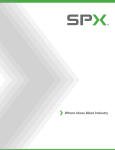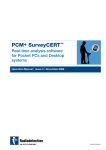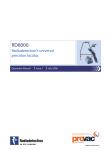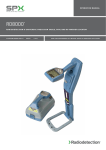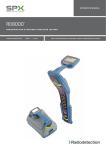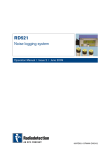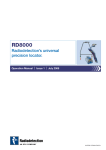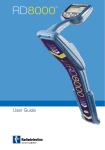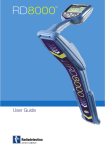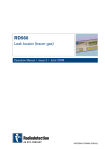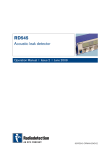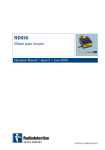Download SurveyCERT Operation Manual
Transcript
RD8000 SurveyCERT™ Real-time analysis software for Pocket PCs and Desktop systems. Operation Manual l Issue 2 l September 2008 90/SURVEYCERT-ENG/02 Preface Before you begin Trademarks Please read this user manual before installing SurveyCERT™ to your PC or PDA. SurveyCERT is a trademark owned by Radiodetection LTD, all rights reserved. Read your Pocket PC user documentation thoroughly before attempting to bond the RD8000 Receiver to your Pocket PC or similar device. Windows, Windows Vista, Windows Mobile, ActiveSync and Microsoft Excel are registered trademarks of Microsoft Corporation, all rights reserved. Note that this manual and all its contents are subject to change. Radiodetection products are under continuous development. ArcGIS is a trademark of ESRI, all rights reserved. Radiodetection Limited reserves the right to modify the product without notice and some product changes may have taken place after this user manual was published. Contact your local Radiodetection dealer or visit www.radiodetection.com for the latest information about the RD8000 product family, including this manual and the bundled software Important Notice Radiodetection makes every effort to ensure that all technical information, statements and recommendations about RD8000 products are based on information believed to be reliable, but the accuracy or completeness thereof is not guaranteed. In no event shall Radiodetection be liable for any loss, inconvenience, damage or problems caused through use of any equipment or software. Before using any RD8000 product (including SurveyCERT™), the user should determine the suitability of the product for its intended use. The user assumes all risks and liability whatsoever in connection with such use. Use of the SurveyCERT™ software is bound by license agreement, a copy of which is included in the SurveyCERT™ download bundle. Copyright Statement This manual is Copyright © 2008 Radiodetection LTD. All rights reserved. Radiodetection LTD is a subsidiary of SPX Corporation. ii SurveyCERT™Operation Manual MapInfo Professional is a trademark of MapInfo, all rights reserved. The Bluetooth word mark and logos are owned by the Bluetooth SIG, Inc. and any use of such marks by Radiodetection Ltd. is under license. Open Office Calc is an open source project released under the GNU Lesser General Public License. Training Radiodetection provides training services for most Radiodetection products. Our qualified instructors will train equipment operators or other personnel at your preferred location or at Radiodetection headquarters. For more information go to www.radiodetection.com or contact your local Radiodetection representative. Table of Contents 8.2 To Change the GPS port settings on the SurveyCERT™ application 12 ii Section 9. – ESRI ArcGIS 13 Copyright Statement ii 9.1 Formatting the ENT file 13 Trademarks ii 9.3 Importing data to ArcGIS 14 Section 1. – Introduction 1 Section 10. – Appendix 15 1.1 Overview 1 10.1 ENT file format 15 1.2 About this manual 1 10.2 PDA Resolution 15 1.3 Applications 1 10.3 Setting receiver model 15 Section 2. – Installation 2 2.1 System requirements 2 2.2 Installing on Windows 2 2.3 Installing on Pocket PC 2 Section 3. – Basic Operation 3 3.1 Main Menu (PC version) 3 3.2 The Toolbar 4 3.3 The Status Bar 4 3.4 Settings Menu 4 3.5 The Main Window 5 3.6 File Manager 5 Section 4. – SurveyCERT™ Charts 6 Preface ii Before you begin ii Important Notice Section 5. – Using the RD8000 Receiver with your PDA 7 5.1 Pairing the devices 7 5.2 Activate GPS (Optional) 7 5.3 Logging data 8 Section 6. – Using the RD8000 Receiver with your PC 9 6.1 Pairing 9 6.2 Advanced Settings Table of Figures Figure 3.1: SurveyCERT™ PC Version 3 Figure 3.2: SurveyCERT™ PDA Version 3 Figure 3.3: PC Settings Window 4 Table 4.1 Locator Mode Charts 6 Figure 5.1: Windows Mobile 5 Bluetooth® Manager 7 Figure 7.1: Reading locate data on the PDA 11 Figure 8.1 Windows Mobile GPS Setup 12 Figure 8.2 GPS and Bluetooth® Port settings 12 Table 10.1 ENT data format 16 9 6.3 Configure the SurveyCERT™ PC application 10 Section 7. – Reading data 11 7.1 Real-time viewing 11 7.2 Desktop viewing 11 7.3 Raw data view 11 Section 8. – Advanced GPS setup 12 8.1 To Check, Enable or Change your GPS port settings 12 SurveyCERT™ Operation Manual iii Section 1. – Introduction Thank you for your interest in SurveyCERT™. The RD8000 platform provides fast locate and effective measurement of pipeline coating faults. Radiodetection has engineered the RD8000 to communicate with third-party devices such as PDAs using a Bluetooth® connection. frequency modes supported by the RD8000 receiver. The free download bundle includes the following files: Section 7 contains advanced GPS setup options. • This manual in PDF format • A readme file and EULA Section 5 provides detailed instructions on bonding and using your Pocket PC with the RD8000 Receiver. Section 6 gives an overview of the methods available for reading SurveyCERT™ logs on your PC or PDA. Section 8 provides details on how to import the SurveyCERT™ data log into ESRI ArcGIS and Section 9 contains Appendices for developers and advanced users. • The SurveyCERT™ PDA application • The SurveyCERT™ PC application 1.1 Overview SurveyCERT™ is an application for Pocket PCs that can read and chart logged data from the RD8000 receiver in real-time. The application is also available as a desktop viewer for Microsoft Windows® XP™ and Vista™. This version is optimized for larger screens but includes all the features of the PDA version, including the ability to import logged data from the receiver via a Bluetooth® connection. 1.3 Applications The RD8000 is designed to be a flexible platform that is interoperable with a broad range of industry applications. One such application is the field of Geographic Information Systems (GIS). Broadly, GIS is a discipline dedicated to the analysis of spatial information that can be drawn from a wide range of sources, including GPS data, which is supported by SurveyCERT™. Refer to Section 8 for an overview of using RD8000 locate data with ESRI ArcGIS. The PDA version is optimized for use on a VGA (or quarter VGA) PDA running Windows Mobile®. To maximise your experience using the software, Radiodetection recommends using the software with a Bluetooth® and GPS enabled PDA. 1.2 About this manual This manual provides RD8000 users with instructions on how to use your Bluetooth® and GPS enabled Pocket PC, PDA or Smart Phone with the RD8000 Receiver. Also included is a developer guide intended for GIS professionals. The guide provides a brief tutorial on how to convert the SurveyCERT™ data log to a format compatible with ESRI ArcGIS. Section 2 provides users with installation instructions for desktop and Pocket PC systems. Section 3 provides an overview of the PDA and PC program’s basic function. Section 4 lists the range of charts offered with the various SurveyCERT™ Operation Manual Section 2. – Installation SurveyCERT™ runs on either a desktop/laptop PC or a Windows Mobile powered PDA or smart phone. 2.1 System requirements Pocket PC Windows Mobile 4.5 or later Bluetooth® wireless module GPS receiver (Optional) PC Microsoft Windows XP Professional with Service Pack 2* Microsoft Windows Vista USB Bluetooth® adapter (Optional)# Microsoft .Net framework (or Visual C++ Redistribution Package) *NOTE Windows XP 64bit is not supported at this time. #NOTE Some internal PC Bluetooth modules may not be compatible. Radiodetection recommends using a USB Bluetooth adapter. 2.2 Installing on Windows NOTE: SurveyCERT™ is also installed with the Radiodetection Enterprise Suite. You do not need to download SurveyCERT™ if you already have this on your system. The PC application is distributed as a standalone executable file. Simply copy the file to your directory of choice and double click to run. Note that to run the program you may also need to install the Microsoft Visual C++ redistribution Package, which is available as a free download from the Microsoft website. This package is not required if you have the .Net framework installed on your computer. Note that at this time, Windows XP 64bit are not supported. SurveyCERT™ Operation Manual 2.3 Installing on Pocket PC To install the application on your Pocket PC device, you must use the Microsoft ActiveSync utility. This utility is usually installed with your Pocket PCs application suite otherwise you can download ActiveSync for free from the Microsoft website. Consult the documentation that accompanied your Pocket PC if you require more information. Windows Vista users please note that you must synchronize your devise using Windows Mobile Device Center. Section 3. – Basic Operation SurveyCERT™ is designed for rapid data capture and analysis in the field. Most functions can be accessed quickly using the toolbar. These functions are identical on the PDA and PC versions of the software. There are several layout differences to note. The PDA version displays the file manager in a popup window and the PC uses a split window that can be adjusted using regular window handlers. 3.1 Main Menu (PC version) Press the Menu button to display the following options: • Settings – opens the Settings window. • X-Axis – adjusts the Index and Distance values on the x-axis. • Autoscale – when On, forces the chart to automatically resize around the current data. Select Off to turn Autoscale off. The PC version also features a Menu bar situated below the Title bar as with standard Windows applications. In the PDA version, the button is located on the Toolbar. • Exit – Exits the program. 2 1 1 3 4 2 3 Figure 3.1: SurveyCERT™ PC Version Figure 3.2: SurveyCERT™ PDA 1. Main/Chart Window 2. Toolbar 3. Status Indicators 4. File Manager SurveyCERT™ Operation Manual 3.2 The Toolbar • Menu (PDA only) – opens the settings window. • New – creates a new trace. • Open – opens an existing trace saved in the ENT file format. • Save – saves the current trace as an ENT file on your PDA. • Logging Toggle – when selected, this option sends data from the RD8000 receiver to your PDA. • Locator Mode Toggle – changes the currently displayed locator mode. • Chart Toggle – toggles the different charts available to each Locator Mode (refer to Section 4). • Grid Toggle – displays a latitudinal/longitudinal grid in the main window. • Range Toggle – displays the latitudinal/longitudinal range in the main window. 3.4 Settings Menu To access the Settings window on the PDA press the Menu button with your stylus; on the PC version select Menu -> Settings from the Main Menu bar. The Settings window allows you to configure the following options: • Grid – adjusts the number of longitude and latitude grid lines. • Colour – adjusts background and high/low value colors. • Ports – allows users to adjust the Bluetooth® and GPS port settings of the application. These settings must match your PDA’s Bluetooth® and GPS receiver ports; otherwise the application may be unable to communicate with the RD8000 receiver and the GPS network. • Test – displays raw connection data as plain text in the main Window. Use this option to test or troubleshoot your Bluetooth® and GPS connections. 3.3 The Status Bar The status bar on the bottom of the Main Window provides connection and co-ordinate information. The Status Bar includes the following indicators: • Bluetooth® indicator – indicates that a Bluetooth® connection is present. If this icon remains greyed out, check your connection settings. • GPS indicator – indicates that a GPS connection is present. If this icon remains greyed out, check your connection settings. • Locator Mode indicator – indicates the RD8000 receiver’s current locator mode. • Zoom indicator – indicates the current x-axis and y-axis zoom settings. • Position Indicator – displays the graph co-ordinates when the stylus is pressed on the main window. • Log Indicator – Indicates whether the PDA is logging data from the RD8000 receiver. If either the GPS or Bluetooth® link is lost during logging, the application will continually attempt to re-establish the link. SurveyCERT™ Operation Manual Figure 3.3: PC Settings Window 3.5 The Main Window 3.6 File Manager This window displays logged data in a range of charts. The window also features navigation and zoom buttons that allow you to pan or enlarge on a selected area. Press the Main Window with your PDA stylus to activate the context menu. The File Manager displays the current active trace file along with any other trace files you choose to open. When you open the program, a temporary blank trace file is created, ready to receive data from the RD8000 Receiver. This file by default is the current active trace. The context menu gives you the following options: When a trace is active it can be edited with new trace data logged from the RD8000 Receiver. • Settings – shortcut to the applications Settings Menu. • X-Axis Distance – sets the X-Axis of the chart to the distance of the first GPS co-ordinate. • X-Axis Index - sets the X-Axis to be a contiguous index for each data position in each locator mode. This mode is essential if GPS is unavailable or if GPS accuracy is insufficient. • Zoom In – zooms in at the selected point.* • Zoom Out – zooms out at the selected point.* • Horizontal Shrink – zooms in along X axis.* The File Manager allows you to load multiple locate files and view them as an overlay on your current or active trace. You can open additional files by pressing the Open icon on the Toolbar and then selecting an existing ENT file from an earlier trace. Once multiple files are open, you can define whether a file is visible on the main chart window, what color it is and whether the file is active or not. To adjust these settings on the PC version, Right Click the file name to display the context menu. From there you can Activate the file, delete it, display or hide it and change the color. • Horizontal Stretch – zooms out along the X axis.* • Vertical Shrink – zooms in along Y axis.* • Vertical Stretch – zooms out along the Y axis.* • Recentre – centers the current view relative to the selected point.* • Restore – returns the Main Window to its default view.* • Autoscale – when On, forces the chart to automatically resize around the current data. Select Off to turn Autoscale off.* *Function not available when autoscale is enabled. SurveyCERT™ Operation Manual Section 4. – Survey charts The primary function of the desktop and PDA version of the software is to display locate data captured using the RD8000 receiver. As such, both platforms are able to display graphs corresponding to the frequency selection modes on the RD8000 receiver. The following table shows what information is displayed by the various Locator Modes offered by the RD8000 receiver. Table 4.1 Locator Mode Charts Available charts Mode Depth Locate I 8KFF dBMV • POWER • CPS • Phase • TSG • • • CDFF • • ACTIVE • • CD • • SurveyCERT™ Operation Manual • • • • • The program allows users to import and chart survey data collected using the RD8000 receiver using a compatible PDA or PC. When used in the field with a Bluetooth® and GPS compliant device, the program will chart locate data in real-time using positional information. If using a PDA without a GPS receiver, the PDA will only log the receiver’s data. Once logged, you can send this data to a PC and use it with your company’s preferred GIS platform. Section 5 – Using the RD8000 receiver with a PDA The portability of a PDA allows you to operate the RD8000 receiver and gain real-time information for extended periods in the field. If your PDA features a GPS receiver, SurveyCERT™ will automatically add GPS information. For information on the GPS data format, refer to Appendix 9.1. 3. Once your PDA is paired with the RD8000 receiver, you can toggle the receiver’s Bluetooth® mode to Auto. In Auto Mode, the receiver will attempt to connect to the paired PDA when the devices are within 10 meters of each other. 5.1 Pairing the devices Bluetooth® devices must be paired before use. The following procedure provides an example of how to pair the RD8000 receiver to your PDA. For more information, consult the RD8000 Operation Manual and your PDA’s documentation. On the RD8000 receiver 1. Press the Power Key to switch on the unit. 2. Press the Power Key once and then press the UP Arrow Key once to display BLUT. 3. Press the Power Key once and then press the DOWN Arrow Key to display PAIR. 4. Press the Power Key once to enter Pair mode. On your Pocket PC 1. Pair your Pocket PC to the RD8000 receiver with your Pocket PC’s Bluetooth® software. Note that the procedure for pairing your PDA differs with each model; consult the documentation that came with your PDA for more information. The following example should apply to most Pocket PCs running Windows Mobile 5. a. From the Start menu on the PDA, select Settings, then select the Connections Tab and then select the Bluetooth® icon. b. Ensure the Bluetooth® Radio is on and make the PDA visible to other devices c. Select the Devices tab and scan for new partnerships. d. Create a partnership with the RD8000. e. Select the COM Ports tab and make a New Outgoing Port with the RD8000 (RD8K_xxxx where xxxx is the firmware version). Note the port number of the selected COM port. Figure 5.1: Windows Mobile 5 Bluetooth Manager 5.2 Activate GPS (Optional) If your PDA features an integrated or external GPS receiver you can log positional co-ordinates to your locate data gathered with the RD8000 receiver. Note that GPS functions differ in each PDA so check your PDA’s documentation if you need help establishing a link to the GPS network. Once the GPS receiver is active, launch SurveyCERT™. Note the Bluetooth® and GPS indicators beneath the status bar. If either connection is established, the icons will be bright blue. If there is no connection, the icons will be grayed out. Note that it may take several moments to find an active connection. If the either connection is still inactive after several moments, check to ensure your GPS receiver is active SurveyCERT™ Operation Manual and your Bluetooth® radio is active and paired to the RD8000 receiver. If problems continue, you may have to alter the Bluetooth® and GPS port settings in the application’s Settings Menu (See Section 3.4). 5.3 Logging data in realtime Once Bluetooth® and the optional GPS connections are established you can send data from the Receiver to your PDA using the following procedure: 1. Create a New Trace by clicking on the New Document icon on the SurveyCERT™ PDA toolbar. This creates a new active trace and ensures that any existing or older traces are not overwritten. 2. On the RD8000 receiver, select the SEND option from the settings menu. The Receiver will now attempt to stream data to any paired device. 3. On your PDA, enable Bluetooth® logging by pressing the Logging Toggle icon on the SurveyCERT™ PDA toolbar. This allows the PDA to receive data logs from the RD8000 Receiver. 4. Begin your survey with the RD8000 receiver and a Radiodetection transmitter as described in the RD8000 Operation Manual or User Guide. 5. When you find a reading you want to record, press and hold the Antenna Select key on the RD8000 receiver. The SurveyCERT™ bar graph will spike and then return to its previous value. The data will now be stored in your PDA’s memory and displayed in your current active trace. 6. Continue your survey and log your findings as described in Step 5. 7. Once the survey is completed, press the Disk icon on the SurveyCERT™ PDA toolbar to save the survey data as a ENT file on your PDA. 8. Once saved you can open the file using SurveyCERT™ on your PDA or desktop software or export it for analysis in your preferred spreadsheet or GIS application. SurveyCERT™ Operation Manual Troubleshooting Log Connections If you have correctly established the Bluetooth® and optional GPS connections but cannot receive logged data, please check the following: Make sure the SurveyCERT™ PDA application is set to receive data by press the Log mode button on the toolbar. Make sure the SurveyCERT™ PDA application is set to the same locate mode as the receiver. If the modes are different the PDA will still record the data however it will not be displayed on-screen. If you have trouble logging in realtime, you can conduct your survey and send the data to your PDA or PC later. Note that the graph doesn’t display data until a second measurement is taken. Section 6 – Using the RD8000 receiver with your PC You can send data from the RD8000 receiver straight to your Bluetooth® compliant desktop or laptop PC. To do this you must first pair the two devices. Once paired the Bluetooth® link will allow you to send logged data to your PC where you can read it using the SurveyCERT™ PC application or import it into your preferred GIS platform. 6.1 Pairing Bluetooth devices must be paired before use. The following procedure provides an example of how to pair the RD8000 Receiver to your PC. You can make the connection using a USB Bluetooth® adapter providing it supports the Bluetooth® Serial Port profile. ® Note that the steps for pairing Bluetooth® devices may differ depending on the brand of computer or the USB adapter you have. As such, the following procedure is a guide only. 5. A device named RD8K_xxxx should appear, if it doesn’t make sure the RD8000 receiver is in Pair Mode and click Search Again. 6. Select the RD8k_xxxx and click Next. 7. Tick ‘Use the passkey found in the documentation’, enter 1234 for the passkey and click Next to pair with the RD8000 receiver. 8. Completing the Add Bluetooth Device Wizard will be displayed for a successful pairing. 9. Note the Incoming COM port assigned to the device and click Finish. 6.2 Advanced Settings Once paired, you must check to see if your PC’s Bluetooth® port is configured to the same Baud rate and parity settings. These settings can be adjusted as follows: For more information, consult the RD8000 Operation Manual and your PC or Bluetooth® module’s documentation. 1. Right-click My Computer and select Properties. On the RD8000 receiver 3. Expand the Ports(COM & LPT) menu tree and double-click the device assigned to the Bluetooth® Incoming port. 1. Press the Power Key to switch on the unit. 2. Press the Power Key once and then press the UP Arrow Key once to display BLUT. 3. Press the Power Key once and then press the DOWN Arrow Key to display PAIR. 4. Press the Power Key once to enter Pair mode. On your PC 1. Connect a USB Bluetooth® adapter that supports the Bluetooth Serial Port Profile into a USB port. a. Alternatively if your PC features an integrated Bluetooth® module, switch it on following the documentation that came with your computer. 2. Select the Hardware tab and then select Device Manager. 4. Select the Port Settings tab and set: a. Bits per second to 115200, b. Data bits to 8, c. Parity to None, d. Stop bits to 1 and e. Flow control to Hardware. 5. Click OK to return to the Device Manager. 6. Close the Device Manager. 2. Select Start -> Control Panel and double click on ‘Bluetooth Devices’. 3. Click on Add to run the ‘Add Bluetooth Device Wizard’. 4. Tick ‘My device is set up and ready to be found’ and click Next to search for Bluetooth® devices. SurveyCERT™ Operation Manual 6.3 SurveyCERT™ PC configuration Once the connection is established and you have configured your Bluetooth® port settings, you must now configure the SurveyCERT™ PC application to receive data on the selected Bluetooth® port. To do so, please use the following procedure. 1. If you haven’t already, open the SurveyCERT™ PC application by double-clicking its icon; this will create a settings file, 2. Close the SurveyCERT™ PC application, 3. Locate the settings file, SurveyCERTIni.txt in the directory where you installed the SurveyCERT™ PC application, 4. Open the settings file in Notepad, 6.4 Receiving Data Once the connections are established, you can send the logged data from the RD8000 receiver to the PC application. To do so: 1. On the SurveyCERT™ PC application, create a new trace and press the Log button on the tool bar. 2. On the RD8000 receiver select the SEND option from the settings menu. 3. If the connection is successful, the PC application’s Bluetooth® icon will become active and the logged data will appear on-screen. 5. Find the line PORT#BLUETOOTH#PORTNUMBER#, 4. Check to see if all data has transferred by toggling through the receiver modes on the SurveyCERT™ PC Application. 6. Add the correct port number to the end of the line, 5. Save the file by selecting Save As from the File Menu. 7. Note if your PC is connected to a Bluetooth® GPS receiver, you can also add the port number the GPS device is using in the line PORT#GPS#PORTNUMBER# 8. Save the file and exit; you may now reopen SurveyCERT™ on you PC. 10 SurveyCERT™ Operation Manual Section 7. – Reading data You can read logged data in several ways. You can use the SurveyCERT™ PDA application to read data in realtime or open previous trace files. For large screen viewing, you can save the date to your laptop to desktop PC and open it using the SurveyCERT™ PC version. Alternatively, you can view and manipulate the raw data in a plain text editor or CSV compatible spreadsheet application such as Microsoft® Excel™ or Open Office Calc. 7.1 Real-time viewing You can view the logged data as you record it in real time. This process occurs automatically when a recorded log is sent from the RD8000 receiver to the PDA. Each data log will appear in the active trace window as a vector or point, depending on the chart mode you have selected. You can compare an active trace to historical traces saved on your PDA, providing you with rapid analysis in the field. Refer to Section 4 for a list of supported charts. 7.2 Desktop viewing Away from the field, you have the option to view one or more traces on a desktop or laptop computer using the SurveyCERT™ PC viewer. The desktop viewer provides you with the same analysis tools but utilizes the desktop’s larger screen environment. Refer to Section 4 for a list of supported charts. Figure 7.1: Reading locate data on the PDA 7.3 Raw data view If required, you can view the raw data log in a plain text editor or any spreadsheet application that supports CSV plain text import. Microsoft Excel and Open Office Calc are both capable of importing CSV data. This allows you to format the data for use in GIS applications such as ESRI ArcGIS or MapInfo Professional. SurveyCERT™ Operation Manual 11 Section 8. – Advanced GPS setup To use GPS with SurveyCERT™ on your PDA, you may have to map your PDA’s GPS port to match those found in the SurveyCERT™ setup menu. Alternatively, if your PDA does not permit you to change its GPS port, you can change the port settings found in the settings menu of SurveyCERT™. Note GPS settings will differ depending on your PDA’s brand and as such this information is intended as a guide only. Consult your PDA’s user documentation for more information. 8.1 Configuring GPS port settings 1. From your PDA’s Start menu, select Settings, then select the System Tab and then select the GPS icon. 2. In the GPS settings page, go to the Programs Tab. a. Figure 8.1 Windows Mobile GPS Setup Note the GPS COM port number and Baud rate. An example is shown in Figure 7.1. 3. If applicable, ensure that this port is enabled. 4. Advanced users only. If necessary, change this port number and baud rate to match the settings in the SurveyCERT™ settings menu. 8.2 SurveyCERT™ GPS settings 1. Check the port number and baud rate of your PDA’s GPS receiver. 2. Open SurveyCERT™ and press the Menu button on the toolbar. 3. Select the Ports Tab. The PC settings page is shown in Figure 7.2 as an example. 4. If necessary, change the GPS port number and baud rate to match the GPS receiver’s settings. 5. Select the Test Tab and check the GPS box (and Bluetooth® if required). 6. Press OK; if the connection is successful, the main window will display raw GPS (and Bluetooth®) data. 12 SurveyCERT™ Operation Manual Figure 8.2 GPS and Bluetooth® Port settings Section 9. – ESRI ArcGIS This section provides an example of how to format the R8000 data log for export into ESRI ArcGIS. The RD8000 receiver stores data as comma-separated variables (CSV); the data is then saved as a plain text file with a .ENT extension. The CSV format allows you to import the tabular data to ArcView where you can then convert the data to a shape file and manipulate the trace as a map layer. Note that there are several methods for using the RD8000 data in your GIS environment; the method outlined here is intended as an example workflow only. 9.1 Formatting the ENT file The ENT file is saved in CSV format with a .ENT extension. Before importing the data into ArcView you must add table headers to the data and give the file a CSV extension. You can do this manually in any plain text editor or in a spreadsheet application that supports the CSV format. The example uses Microsoft Excel 2003 and 2007, however the process should be similar in older versions of Excel and Open Office Calc. Formatting in Excel 1. Copy the ENT file from your PDA or the RD8000 Receiver to your computer using Bluetooth® or ActiveSync (Pocket PC only). 2. Open Microsoft Excel and create a new spreadsheet. 3. In Excel 2003 and earlier, select Data -> Get External Data -> Import Text File. 4. In Excel 2007, select the Data tab and click From Text. 8. Press Next. 9. In Screen 2, select Comma as the delimiter and deselect all other delimiters. You should now see a preview of your formatted data. 10. Press Next. 11. Screen 3 allows you to change the cell type of each column. In almost all applications, it is sufficient to leave the default General cell type. 12. Press Finish. 13. Excel will now import your data beginning at the row you selected. If you chose Row 2, you will have an empty row in which to add the headers. If you specified Row 1 then you will have to insert a new row above your data. Adding headers. ArcView and other ESRI programs require that headers are added to CSV files. The ENT file does not include headers and so they must be added manually. Alternatively, you could create a template with the headers in place or you could automate the process using VBA. Note that you can give the headers any name you wish, however for ESRI programs they must be in CAPS and contain no spaces. Although the headers are not logged with the file, SurveyCERT™ always logs the data in the same format using pre-existing headers within the RD8000 receiver. These headers are detailed in Appendix 9.1. Once you have added headers you should then save the data as a CSV file. You are now ready to import the data to ArcView using the following procedure. 5. When the Import File dialogue box appears, choose All Files from the Type of Files drop-down box. Next, navigate to the ENT file, select it and press Import. 6. Excel will then display a Text Import Wizard. 7. On the first screen, select the Delimitated radio button. Next, choose which row you want the data to begin at. Row 2 is recommended as you will need to add the header columns. For file origin, the default value is usually correct. SurveyCERT™ Operation Manual 13 9.3 Importing data to ArcGIS 1. Open ArcMap. You can add the data to a new map project or to an existing one. If you have existing map data for your survey area, you can overlay one or more RD8000 location datasets into your project for analysis. 2. To import the data go to Tools -> Add XY data... 3. Select Choose File and select your formatted CSV file using the file browser. 4. Once the file is selected you must then specify your X and Y fields using the drop down menus. The menus will list the headers you added in Excel. Choose the headers most applicable to your application (usually the Longitude and Latitude data). 5. Next select the projection appropriate to your survey. 6. Press Done, ArcMap will now import the data as a layer in your project. 7. You can now save the layer as a shape file by right-clicking the layer and selecting Data -> Export Data. Choose a file name for the new shape file and ensure the Import check box is selected. Press Save. Your map will now contain a new shape file layer that you can manipulate according to your requirements. You can now safely discard the CSV layer and save your project. 14 SurveyCERT™ Operation Manual Section 10. – Appendix 10.1 ENT file format This appendix provides developers with detailed information on the SurveyCERT™ data format. The RD8000 stores locate information as comma separated variables using a plain text file with the extension, ENT. These variables are formatted according to predefined headers that carry data specific to the RD8000 receiver’s trace information. The file also contains GPS header information based on the NMEA specification. Note if a GPS receiver is not used during the survey, the GPS value data will default to NULL or 0 values. 10.3 Setting receiver model The ini file should be set to reflect your receiver model. 1. Open the ini file in Notepad or any plain text editor 2. Find the line: UNIT#MODEL#<string> 3. Replace the string, if present, with your correct model type i.e. either: a. RD8000PXL b. RD8000PDL The headers are implied and are not included in the ENT file. This allows developers to define custom headers that best suits their host application. Table 10.1 (overleaf) displays header information in the Data column. The Values column lists the type of data contained in each entry with an explanation where applicable. 10.2 PDA Resolution By default the PDA is set to display at VGA resolution (640x480 pixels). If your PDA does not support this screen size you have the option to change the size of the application to quarter VGA. This option cannot be set in the application itself; to do so you must edit the program’s settings file using the following procedure. 1. First shut down the PDA application. 2. Locate the SurveyCERTIni.txt file on your PDA. Note this file is created at first runtime and is usually stored in the location of the exe file. 3. Open this file in any plain text editor. 4. Find the line: SCREEN#RESOLUTION#FULL 5. Change to SCREEN#RESOLUTION#QUARTER and be sure to use all caps. 6. Save and close the file. 7. Re-launch the PDA program; the window size should now fit you PDA screen. SurveyCERT™ Operation Manual 15 Table 10.1 ENT data format Col # Data Values Comments Specifies the locate mode when reading was taken RD8000 logging data 1 Locator mode <String> 2 File Index <Integer> 3 Locate Depth <Float> Depth in meters 4 Locate Current <Float> Current in mA 5 Phase <Float> Phase in degrees 6 Signal <Float> Signal level in dBmV 7 Signal strength <Float> 8 Gain <Float> Optional GPS Data 9 GPS UTC <Double> GPS Universal Time Code 10 GPS Latitude <Double> Latitude in degrees 11 GPS Latitude Direction 0 – Unknown 1 – North 2 – South 3 – West 4 – East 12 GPS Longitude <Double> 13 GPS Longitude Direction 0 – Unknown 1 – North 2 – South 3 – West 4 – East 14 GPS Fix Quality 0 – None 1 – GPS 2 – DGPS 3 – PPS 4 – Kinematic 5 – RTK 6 – Estimated 7 – Manual 8 – Simulation 15 GPS Number of Satellites <Integer> 16 GPS Horizontal Dilution <Double> 17 GPS Altitude <Double> 18 GPS Altitude Units 0 – Invalid Longitude in degrees Specifies the type of precision used Altitude in meters 1 – Meters 19 GEO ID Height <Double> 20 GEO ID Units 0 – Invalid 1 – Meters 21 DGPS Time since Update <Integer> 22 DGPS Station ID <Integer> 23 Time 0 – System 1 - GPS Specifies if the time is set by the GPS network or by the GPS receiver’s internal clock 24 Day Integer Day of Month (1-31) 25 Month Integer Month of Year (1-12) 26 Year Integer 4 Digit Year 16 SurveyCERT™ Operation Manual Time in seconds America Europe Asia-Pacific Radiodetection 154 Portland Road Bridgton, ME 04009, USA Tel: +1 (207) 647 9495 Toll Free: +1 (877) 247 3797 Fax: +1 (207) 647 9496 Email: [email protected] Radiodetection (UK) Western Drive Bristol BS14 0AF, UK Tel: +44 (0) 117 976 7776 Fax: +44 (0) 117 976 7775 Email: [email protected] Radiodetection (Asia-Pacific) Room 708, CC Wu Building 302-308 Hennessy Road, Wan Chai Hong Kong SAR, China Tel: +852 2110 8160 Fax: +852 2110 9681 Email: [email protected] Pearpoint 72055 Corporate Way Thousand Palms CA 92276, USA Tel: +1 800 688 8094 Tel: +1 760 343 7350 Fax: +1 760 343 7351 Email: [email protected] Radiodetection (Canada) Unit 34, 344 Edgeley Blvd. Concord, Ontario, Canada L4K 4B7 Tel: +1 (905) 660 9995 Toll Free: +1 (800) 665 7953 Fax: +1 (905) 660 9579 Email: [email protected] Radiodetection (France) 13 Grande Rue, 76220 Neuf Marché, France Tel: +33 (0) 232 8993 60 Fax: +33 (0) 235 9095 58 Email: [email protected] Radiodetection (Benelux) Industriestraat 11, NL 7041 GD’s-Heerenberg, Netherlands Tel: +31 (0) 314 66 47 00 Fax: +31 (0) 314 66 41 30 Email: [email protected] Radiodetection (Germany) Groendahlscher Weg 118 D-46446 Emmerich am Rhein, Germany Tel: +49 (0) 28 51 92 37 20 Fax: +49 (0) 28 51 92 37 520 Email: [email protected] To see the full range of products and services provided by Radiodetection visit: www.radiodetection.com Radiodetection products are under continuous development and are subject to change, we reserve the right to alter or amend any published specification without notice. SurveyCERT is a Trademark of Radiodetection Ltd. Copyright 2008 Radiodetection Limited. All rights reserved. Radiodetection Ltd. is a subsidiary of SPX Corporation. 90/SURVEYCERT-ENG/02 Radiodetection (China) Hong Fu Group Office Building Room 322-326 Bei Qi Jia Township, Changping District Beijing 102209, China Tel: +86 (0) 10 8975 5540 Fax: +86 (0) 10 8975 5640 Email: [email protected] Radiodetection (Australia) Mactek Pty. Ltd Unit 14, 5-7 Prosperity Parade Warriewood NSW 2102, Australia Tel: +61 (0) 2 9979 8555 Fax: +61 (0) 2 9979 7733 Email: [email protected]






















